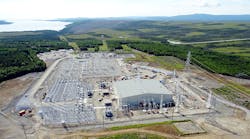ABB recently achieved a major milestone with the successful testing of the Maritime Link, enabling Emera to exchange electricity between the Island of Newfoundland and Nova Scotia for the first time in history.
The Maritime Link is a 500 MW high-voltage direct current (HVDC) connection that will enable clean, renewable energy, generated in Newfoundland and Labrador to be transmitted to the North American grid in Nova Scotia. The stabilizing features of ABB’s latest HVDC Light solution will also allow Nova Scotia to integrate additional renewables and contribute to Canada’s emission-reduction efforts.
The HVDC Light Maritime Link is the first of its kind in the world with a full Voltage Source Converter (VSC) bipolar configuration, to enhance system availability. The converter stations will be equipped with the ABB Ability based advanced MACH control and protection system which acts like the brain of the HVDC link. It monitors, controls and protects the sophisticated technology in the stations and manages thousands of operations to ensure power reliability. Its advanced fault registration and remote control functions also help protect the link from unexpected disruptions, such as lightning strikes.
In addition to the two converter stations for the ±200 kV HVDC link, the project scope also includes two 230 kV alternating current (AC) substations in Newfoundland, one 345 kV AC substation in Nova Scotia and two cable transition stations.
HVDC Light is a solution for long-distance underground and underwater power links and interconnections like the Maritime Link Project. This technology is increasingly being deployed across a range of applications. These include integration of renewable energies from land-based and offshore wind farms, mainland power supply to islands and offshore oil and gas platforms, city center in-feeds where space is a major constraint and cross-border interconnections that often connect across the seas. Its ability to meet grid code compliance ensures robust network connections regardless of application. The latest generation of this technology can transmit power at ±640 kilovolts (kV) over 2,000 kilometers and deliver up to 3,000 MW of electricity – enough to power several million households.


